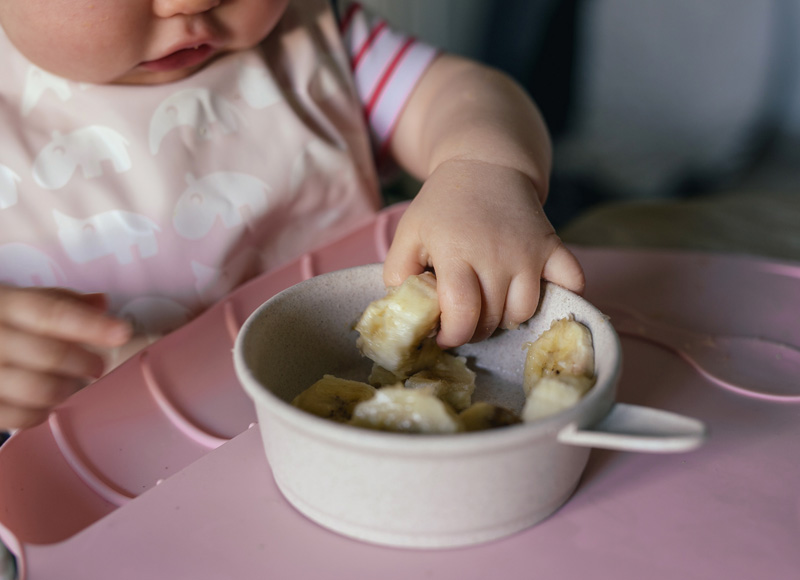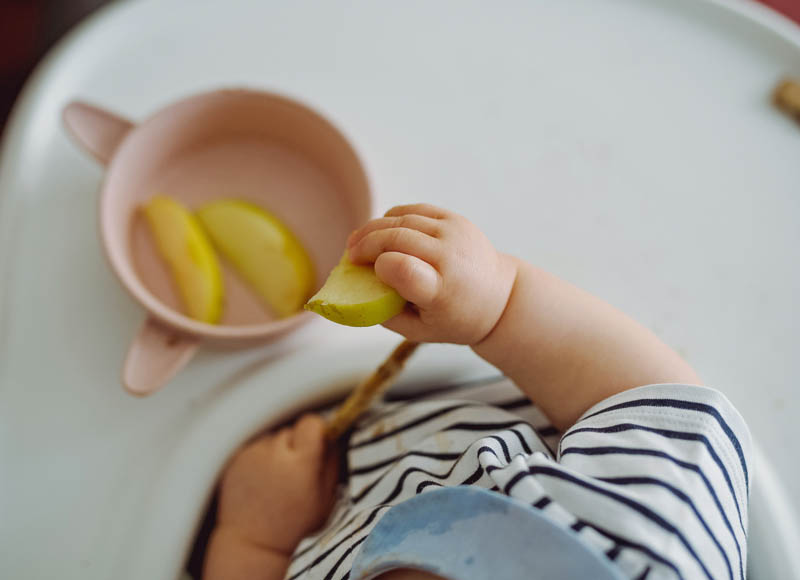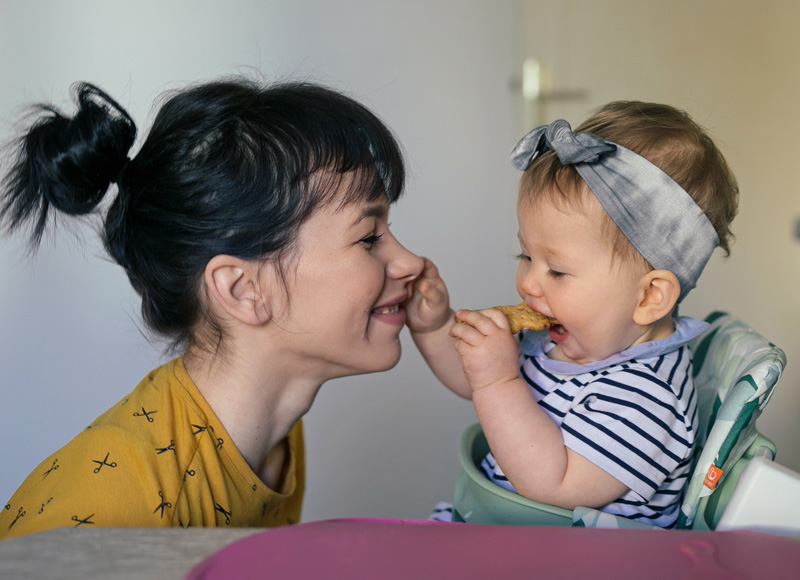It’s always an emotional experience to give your baby taste his first mashed carrots, usually around 4 months. This is the beginning of diet diversification: an important step during the child’s first year that brings its share of questions and uncertainties. When should you start? With what foods and in what quantity? How can you create the right nutritional balance and ensure that all his needs are met? To make sure your first meals are happy moments together, follow the advice of an expert nutritionist early childhood, created with the help of Stokke.
4-6 months: an ideal window
The optimal time period for the taste development of your infant, which corresponds to a peak of growth, the period between 4 and 6 months would be the ideal moment to begin the diversification of food: new nutritional needs and a more mature digestive system make it possible to progressively introduce the vegetables, then the fruits. Marjorie Daman, a nutritionist, however, insists on the need to wait until the end of the 4th month: “I really advise feeding the baby his first vegetables at 4 months old. Before then, the baby is not yet ready when it comes to his digestive system and swallowing ability, and diversifying his diet too early can cause allergies.”
Breastfeeding, a special case?
For a breastfed baby, the timing may be slightly different. “In fact breast milk meets all of the child’s nutritional needs up to 6 months, which is not the case for artificial milks,” says the nutritionist. “The diversification can be done a little later, from 6 months, but not after because there would be deficiencies in iron.”
Prevent and spot allergies
It is as a precautionary principle, to prevent and identify allergies as much as possible, that it is advisable to start the diversification around 4 months and to do it in stages, one food after another, especially in families that present an atopic terrain (predisposition to development of allergies). “For ‘at risk’ children, it is advisable to delay the introduction of certain highly antigenic foods such as eggs, fish, peanuts, soybeans, exotic fruits, celery, orange, mustard and spices,” says Marjorie Daman. As for the signs of a beginning of allergy: “the baby’s cries would be the first symptom, caused by tingling, reflux or stomach aches; swelling or bumps on the body may also be signs of food allergy.”
The 3 keys to food diversification
- When mixing your first mashed potatoes or buying your first jars of baby food, keep in mind that you’re helping to shape the palette of your child’s tastes, which is why “we only offer one vegetable and only one fruit at a time, so that the child can take in each taste,” advises Marjorie Daman.
- Begin with vegetables first, and introduce fruits 10 to 15 days later. Why? “Because sweetness is innate—the baby has this taste from birth, unlike the taste for salty that comes much later. It is therefore suggested to start with vegetables, but choose a “sweet” vegetable to make it more acceptable, such as carrots or squash. We also recommend switching vegetables every day and always choosing seasonal products.
- Do not force it. “If he refuses a vegetable or a fruit, don’t push it, but do try again. It takes between 8 and 10 tries to be able to say that a child does not like a food.”
The importance of rituals and sharing
To make your first meal a happy and serene moment, it is essential to allow your child to play and accept this new ritual. Marjorie Daman advises to keep eye contact while facing him and not to his side, or even, when possible, to eat at the same time as him to “lead by example.” “We know that children are sponges, and at mealtimes, mimicry plays an important role. Let him share this special moment with you, talk to him and let him participate will help defuse his fears.”
Tips for the first meal from Jolanta, mum of Anya (2 years old) and twins Mia and Luna (1 year)
How are the girls’ meals organized? Do you feed them at the same time or one after the other?
When it comes to feeding twins, you have to be clever. You can not feed them at the same time, even if both are hungry: it’s messy and usually both hungry babies end up crying. Feeding them one after another does not work either: it is indeed taking the risk of always having a crying baby watching his sister eat. So, I start feeding them 15 minutes before they are hungry. As a mother, you feel when the time is right! I put one of the babies in the Stokke chair and give her toys: this way she is busy and does not even think about eating. During this time, I quickly feed the other twin. The most important thing is to understand which baby is the most hungry!
Do Mia and Luna have distinct tastes? What are their preferences?
Fortunately for me, they are not difficult, even if they each have their favorite foods. For example, Luna can eat bananas all day long. Mia especially loves sweet potatoes…
How and when did you incorporate fruits and vegetables into their meals?
The girls started eating solid foods late. They were premature babies and I did not feel like they were ready to eat solid food at four months. I waited for them to be six months old and then I added a few spoons of mashed sweet potato in their bottles. Maybe that’s why Mia prefers sweet potatoes now. Two days later, they ate solid foods. The transition took place very quickly and smoothly. Probably because they were born eaters!
Do you have any little tips for them to taste new things?
Not really. On the other hand, it’s always fun to discover what they do not like. I remember when we gave Luna Fennel. You should have seen her face!
What do you like with your Stokke Tripp Trapp chairs?
It truly saved our lives! First, I love their design. This is the only high chair that allows to sit my babies at the same table as us. It is practical, does not take up much space and fits perfectly under the table like any other chair. I like to add different accessories, such as a tray or beautiful cushions. And it is very easy to clean! Which is very important, especially if you have to clean up after three children at each meal… I remember my eldest daughter’s first chair, which was tall and massive: sometimes I had to wash it in the shower because it was impossible to to clean otherwise… But what I like most about Tripp Trapp is that it evolves with the child. It’s an amazing and unique concept. All you need is a chair for the whole childhood. What other chair can do that?
Find the joyful and lively world of Jolanta, Anya, Mia and Luna on her Instagram account @threebirdies and on her blog Three Little Birds where she tells with humor her life as a young mother of 3 girls under 2 years…
Created by: Stokke x Les Louves
Photo credit: BellyBalloonPhotography x Les Louves
Translation: Ashley Griffin
Our thanks to Marjorie Daman, dietician nutritionist at the Paramedical Center Le Sart – Pavé de Lille.
Read more on Les Louves
The first nights: advice and tips to help your baby sleep
Baby’s first outings: how to introduce your child to the world around him
From 0 to 12 months: how to play with your baby








